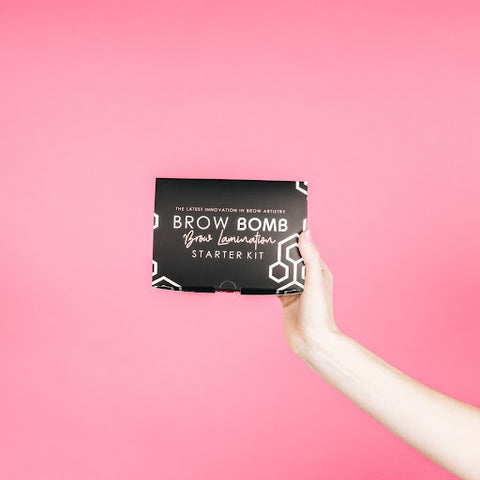Brow Lamination vs. Microblading: Which Treatment Is Best?
Brow lamination vs. microblading is a common question among clients looking for fuller, more natural-looking brows. As a salon owner or stylist, offering both treatments is a wise choice. As experts in cosmetic products, including eyebrow tinting kits and lash supplies, we'll explain the key differences between brow lamination and microblading so you can confidently offer the proper treatment to your clients.
WHAT IS A BROW LAMINATION?
Brow lamination is a semi-permanent treatment that straightens and sets your clients' brow hairs in place, creating a fuller, more polished look. This process smooths and lifts the natural brow hairs they already have.
The treatment uses a multi-step process to soften the hair follicle, allowing you to reshape and style it. Once you've brushed the brows into the desired position, a setting solution locks them in place for long-lasting definition.
With proper care, brow lamination can last up to two months, giving your clients a low-maintenance way to achieve perfectly styled brows.
You can further upgrade your client's look by pairing brow lamination with professional brow makeup or a lash dye. The lamination defines and sets their brows in place, while the lash dye adds depth and balance for a more polished, well-framed appearance.
WHAT IS MICROBLADING?
Microblading is a semi-permanent technique that enhances your clients' brows by creating realistic, hair-like strokes with pigment. If they're wondering how to make their eyebrows look thicker, microblading is an excellent solution. It fills in sparse areas for a fuller, more defined look.
Using a handheld tool with fine microneedles, you deposit pigment into the upper layers of the skin, mimicking natural brow hairs. With proper care and touch-ups, microblading can last up to three years, giving your clients a long-lasting, low-maintenance solution for perfectly shaped brows.
BROW LAMINATION VS. MICROBLADING: KEY DIFFERENCES
As a beauty professional, you may have clients wondering whether brow lamination or microblading is the best choice for them. While both treatments enhance the brows, they achieve it in different ways. Let's look at the key differences between the two treatment options.
TECHNIQUE
Brow lamination restructures your client's natural brow hairs using a gentle perm solution and brow lamination adhesive to lift and set them in place. This technique enhances what they already have, giving brows a fuller, polished look.
Microblading, on the other hand, involves tattooing tiny hair-like strokes into the skin with a microblade and pigment. This method fills in sparse areas and creates a more defined shape, mimicking the look of real hair.
LONGEVITY
Suppose your client wants a low-maintenance, flexible option. In that case, brow lamination lasts 6-8 weeks before their brows return to their natural state. It's great for those who like to switch up their look or want a non-permanent enhancement.
Microblading lasts much longer—typically 1 to 3 years, depending on the patient's skin type and aftercare. Because it involves pigment implantation, regular touch-ups are necessary to maintain a fresh appearance over time.
PAIN LEVEL
Clients often ask about pain, but brow lamination is entirely painless. It only involves applying a setting solution to the brows.
Microblading, however, involves a blade, so there is mild discomfort. A numbing cream helps reduce pain, but clients may still feel a light scratching sensation during the procedure.
BEST FOR
If your client already has a good amount of brow hair but wants more volume, shape, and hold, brow lamination is the best choice. It tames unruly hair, makes thin brows appear fuller, and provides a sleek, lifted effect.
Microblading is better suited for clients with sparse or uneven brows since it creates the illusion of real hair where there isn't any. It's ideal for clients who want a long-lasting, more defined brow shape without needing daily makeup.
COST
Brow lamination is a more budget-friendly option. Depending on your location and salon pricing, it usually costs between $50 and $150 per session.
Microblading is a higher investment, typically costing $300 to $800. To maintain the results, touch-ups are required every 12-18 months.
BROW LAMINATION VS. MICROBLADING: HOW DOES IT WORK?
Both brow lamination and microblading enhance your clients' brows, but they use different techniques to achieve the desired look. Here's a step-by-step breakdown of each process.
BROW LAMINATION STEPS
Brow lamination restructures your clients' natural brow hairs to create a fuller, lifted look without permanent pigment.
Here are the general steps:
-
Wear PPE to maintain hygiene and safety.
-
Apply a lifting solution to soften the brow hairs and make them flexible.
-
Shape and comb the brows into the desired position.
-
Apply a setting solution to lock the hairs in place.
-
Optional: Add a brow tint to enhance color and definition.
With practice, you'll perfect this technique to deliver long-lasting, polished brows.
MICROBLADING STEPS
Microblading creates realistic, hair-like strokes by implanting pigment into the skin for a semi-permanent effect.
Here's an overview of the steps:
-
Wear PPE and ensure a clean work area.
-
Outline the brows to achieve symmetry and precision.
-
Apply numbing cream to minimize discomfort.
-
Use a microblading tool to make tiny incisions in the skin.
-
Deposit pigment into each stroke to mimic natural brow hairs.

BROW LAMINATION VS. MICROBLADING: POST-TREATMENT CARE
Brow lamination does not require a lengthy recovery or intense aftercare. Emphasize to your client the importance of avoiding excess moisture and refraining from applying eyebrow makeup for a specified period. Schedule a follow-up appointment to assess results, address concerns, and discuss potential touch-ups or adjustments for future sessions.
Microblading requires a longer recovery and proper aftercare to ensure the best results. If they ask, "What happens if I get my brows wet after lamination?" remind them that water can break down the pigment and affect healing.
To protect their results, clients should keep their brows dry for 7-10 days and avoid sweating, swimming, and saunas. You can also recommend applying a thin layer of aftercare serum to help with healing. They must also avoid picking or scratching scabs, which can cause patchy healing. Lastly, staying out of direct sunlight for 2 weeks will help prevent fading and keep their brows looking fresh for longer.

BROW LAMINATION VS. MICROBLADING: WHICH TREATMENT IS BETTER?
There is no single "better" brow technique—it all depends on your client's needs and desired results.
Brow lamination is ideal for clients who want a temporary, fuller, and more structured look using their natural brow hairs. At the same time, microblading is better for clients with sparse brows who wish for a long-lasting, semi-permanent solution.
Before either treatment, always ask about allergies or sensitivities to avoid a brow lamination reaction or microblading irritation. Educate your clients on proper aftercare to help them maintain their results for as long as possible.
Providing a personalized experience and prioritizing client safety will build trust and keep them returning for future appointments.
FREQUENTLY ASKED QUESTIONS
IS BROW LAMINATION BETTER THAN MICROBLADING?
Brow lamination isn't necessarily better than microblading; it depends on your client's goals. Lamination enhances natural brows for a temporary, lifted look, while microblading creates semi-permanent, hair-like strokes for those with sparse brows.
WHO IS MICROBLADING GOOD FOR?
Microblading is best for clients with thin, sparse, or uneven brows who want a long-lasting, natural-looking enhancement without daily makeup.
WHO IS BROW LAMINATION GOOD FOR?
Brow lamination is ideal for clients with full or unruly brows who want a sleek, structured, and lifted look without committing to a semi-permanent treatment.
WHO IS BROW LAMINATION NOT GOOD FOR?
Brow lamination isn't suitable for clients with very sparse brows, skin conditions like eczema or psoriasis around the brow area, or those with sensitivities to perming solutions.
WHO IS MICROBLADING NOT GOOD FOR?
Microblading isn't recommended for clients with oily skin (as pigment fades faster), certain medical conditions like diabetes or autoimmune diseases, or those prone to keloid scarring.
WHICH EYEBROW PROCEDURE IS BEST?
The best eyebrow procedure depends on your client's needs. Brow lamination is excellent for temporarily styling natural hairs, while microblading provides a long-term solution for clients who need more definition and fullness.
HOW LONG DOES BROW LAMINATION LAST?
Brow lamination typically lasts 6-8 weeks, depending on your client's hair growth and aftercare.
HOW LONG DOES MICROBLADING LAST?
Microblading lasts 1-3 years, with touch-ups recommended every 12-18 months to maintain the best results.
 Skip to content
Skip to content





































